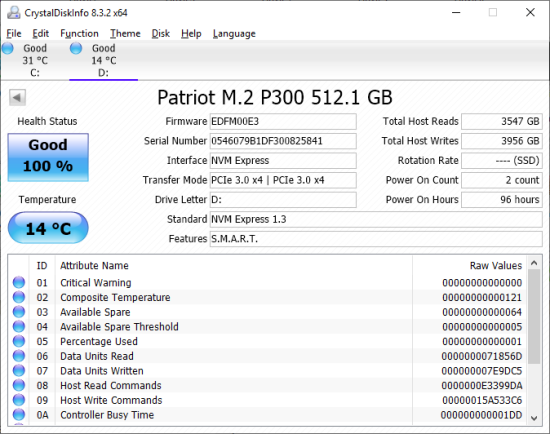TRIM Performance:
While SSD's offer many benefits, there are some downsides to using flash memory. One of the biggest issues people run into is performance degradation. Over time, an SSD will run out of fresh blocks and will have to write over data the file system has marked as deleted. This procedure is very complicated and can slow an SSD's write speeds considerably.
To fix this problem, most manufacturers have added TRIM support to their SSDs. The TRIM command allows an operating system, such as Windows 10, to tell an SSD which data blocks are no longer in use. Using this information, the drive pro-actively erases these blocks and adds them to the free block pool.

To test the P300's TRIM and garbage collection functions, I first put the drive in a "dirty" state. I used Iometer to fill 80% of the drive and then ran a random write test for 30 minutes. Looking at the screenshot below, you can see that the P300's average read and write speeds dropped to 1553.31 MB/s and 369.97 MB/s, respectively.
Patriot P300 - Dirty
To see how well the P300 could recover, I let the computer sit for about 30 minutes and then reran the test. The drive wasn't able to reach the factory fresh performance shown in our earlier tests. However, its sequential write speed jumped up to 1291.51 MB/s.
Patriot P300 - After TRIM
Lastly, I used Parted Magic to perform a secure erase on the P300. With the drive wiped clean, it had average read and write speeds of 1568.32 MB/s and 1347.77 MB/s, respectively.

Patriot P300 - Secure Erased
Final Thoughts:
Patriot's P300 SSD is a great choice for the cost-conscious consumer looking to boost the performance and storage capacity of their desktop or notebook computer. This compact, M.2 form factor SSD is powered by Phison's PS5013-E13T controller and is available with up to 1TB of KIOXIA's (Toshiba) 96-layer BiCS4 3D NAND. Combine this with a PCIe Gen3 x4 NVMe 1.3 interface and you have a drive capable of delivering 25% higher transfer speeds and IOPs than PCIe Gen3 x2 solutions. In our sequential read and write tests, the 512GB version of the P300 was able to read at speeds as high as 1,740 MB/s and write at speeds in excess of 1,549 MB/s. It also did reasonably well in our random write tests, producing nearly 159,000 IOPS, but lagged behind many of the other PCIe SSDs when doing random reads at low queue depths.
Of course, fast read and write speeds aren't the only things the P300 has to offer. Like most TLC-based SSDs, the drive uses an SLC caching algorithm to optimize performance during sustained writes. The P300 also employs features like advanced wear-leveling, end-to-end data path protection, thermal throttling, SmartECC technology and a low-density parity-check (LDPC) ECC algorithm to ensure data integrity and extend the life of the drive. To top it all off, the P300 is covered by a three year warranty.
I'd be remiss if I didn't point out that Patriot is selling two versions of the P300. Here in the US, you'll get what you see in this review. Elsewhere in the world, the drive has a black PCB and is equipped with Silicon Motion's SM2263XT controller. Aside from the name, the only real similarity between the two is that they both use 3D TLC NAND from KIOXIA. At this time it's still up in the air as to whether or not one version is markedly better than the other.
The US version of the P300 is available now in 256GB, 512GB and 1TB capacities. Prices on Amazon.com currently range from $50 up to $130, with the 512GB version reviewed here retailing for about $80.

Highs:
- Available in 256GB, 512GB and 1TB capacities
- PCIe 3.0 x4 interface with NVMe protocol
- Phison PS5013-E13T controller (US version)
- Equipped with KIOXIA 96-layer BiCS4 3D TLC NAND
- Good sequential read and write speeds under most conditions
- Good random write performance
- Small M.2 2280 form factor
- End to end data path protection
- SmartECC technology
- Thermal throttling technology
- Supports APST, ASPM, and L1.2 power saving modes
- Reasonably priced
- 3 year warranty
Lows:
- Mediocre random read performance
- Write speed drops when SLC cache is full
- Does not support hardware based encryption



